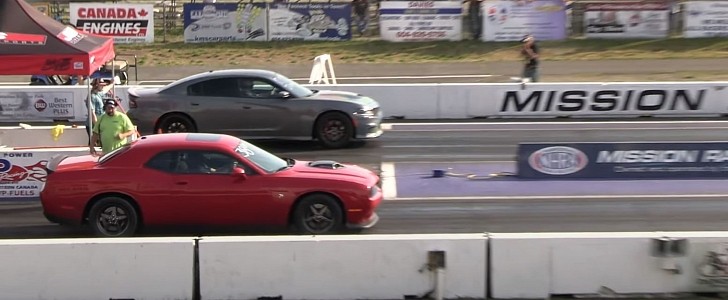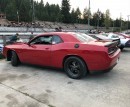I remember going to my first ever official drag racing event back in 2010, and I was fascinated by the sheer diversity of the builds. As cool as some Japanese and European cars might be, everyone was waiting for the muscle cars to pull up to the starting line. That instantly recognizable V8 rumble, which usually leads to temporary deafening during the warm-up procedure, is the kind of sound and sight that make you feel more alive.
That brings us to the topic at hand. A quarter-mile (402 m) race between two vehicles wearing the same badge. A Dodge Challenger versus a Dodge Charger. A Scat Pack versus a Hellcat. So even before the race starts, you can already get an idea about how it is going to go down. Because just by looking at horsepower figures, the Challenger is outgunned, as it only has 485 horsepower, compared to the 707 available on the Charger.
Even though the Challenger is some 300 lbs (136 kg) lighter than the Charger, the Hellcat does come with a supercharger that provides a considerable boost in performance. We've learned that the Challenger belongs to Brandon Sommerville, who owns Sommerville racing, and that his car is completely stock, aside from the Mickey Thompson ET R tires. This was probably just a fun challenge, as the driver of the Hellcat is his friend.
Both drivers do a small burnout to warm-up the tires, and then they line up for the race. As anyone might expect, the Charger should be able to crush the Challenger down the quarter-mile (402 m), but you know what they say about never underestimating your opponent. The event is being held at Mission Raceway Park, in British Columbia, Canada, a facility that's also NHRA approved.
As the lights turn green, the Charger already gets a small advantage, and the driver manages to extend that gap by about three car lengths by the end of the run. As expected, the supercharged Dodge gets the win, finishing the race in just 10.68 seconds, with a trap speed of 134.67 mph (216.73 kph), while the Challenger comes in 2nd, with a time of 11.82 seconds, and a trap speed of just 115.96 mph (186.61 kph).
Even though the Challenger is some 300 lbs (136 kg) lighter than the Charger, the Hellcat does come with a supercharger that provides a considerable boost in performance. We've learned that the Challenger belongs to Brandon Sommerville, who owns Sommerville racing, and that his car is completely stock, aside from the Mickey Thompson ET R tires. This was probably just a fun challenge, as the driver of the Hellcat is his friend.
Both drivers do a small burnout to warm-up the tires, and then they line up for the race. As anyone might expect, the Charger should be able to crush the Challenger down the quarter-mile (402 m), but you know what they say about never underestimating your opponent. The event is being held at Mission Raceway Park, in British Columbia, Canada, a facility that's also NHRA approved.
As the lights turn green, the Charger already gets a small advantage, and the driver manages to extend that gap by about three car lengths by the end of the run. As expected, the supercharged Dodge gets the win, finishing the race in just 10.68 seconds, with a trap speed of 134.67 mph (216.73 kph), while the Challenger comes in 2nd, with a time of 11.82 seconds, and a trap speed of just 115.96 mph (186.61 kph).











